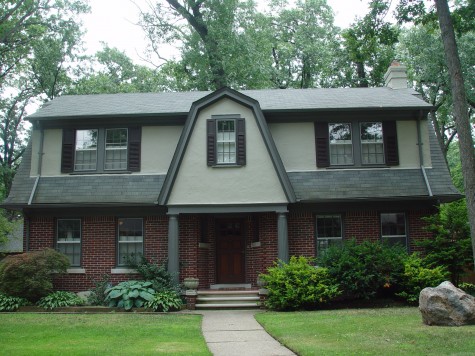 Though my client lives in this lovely old Dutch colonial house, she loves all things modern and minimal. She was interested in a landscape design which would reflect her point of view, yet work with the house. In a book entitled “Minimum” -a gift from her-author John Pawson states that “The minimum could be defined as the perfection that an artefact achieves when it is no longer possible to improve it by subtraction.”
Though my client lives in this lovely old Dutch colonial house, she loves all things modern and minimal. She was interested in a landscape design which would reflect her point of view, yet work with the house. In a book entitled “Minimum” -a gift from her-author John Pawson states that “The minimum could be defined as the perfection that an artefact achieves when it is no longer possible to improve it by subtraction.”
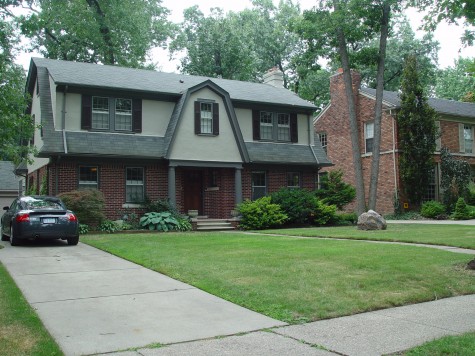 As a landscape is a living thing, and most definitely not an artefact, I told her the best way to achieve the sort of simplicity she was looking for would require a very simple palette of materials. I concentrated on volumes, and values. If you wish to see shapes simply, squint; all the detail will disappear. The house has very definite light and dark shapes. The relative lightness or darkness of a color is known in design lingo as its “value”. I could see a white and dark landscape looking just fine with her home.
As a landscape is a living thing, and most definitely not an artefact, I told her the best way to achieve the sort of simplicity she was looking for would require a very simple palette of materials. I concentrated on volumes, and values. If you wish to see shapes simply, squint; all the detail will disappear. The house has very definite light and dark shapes. The relative lightness or darkness of a color is known in design lingo as its “value”. I could see a white and dark landscape looking just fine with her home.
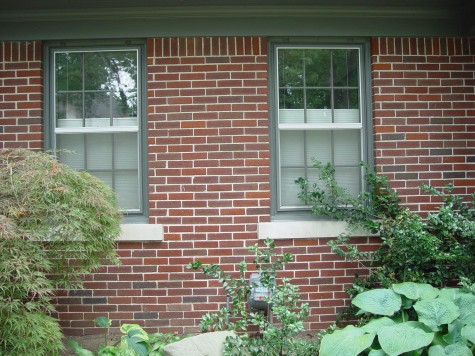 Though the house was built in the 1920’s, its architecture has a very modern feeling. The windows are plain; the shapes of the house and gable are simple and massive. A traditional mix of plant species planted along the foundation, though well grown, had nothing to add. As she planned to do her own work, I did a quick conceptual sketch.
Though the house was built in the 1920’s, its architecture has a very modern feeling. The windows are plain; the shapes of the house and gable are simple and massive. A traditional mix of plant species planted along the foundation, though well grown, had nothing to add. As she planned to do her own work, I did a quick conceptual sketch.
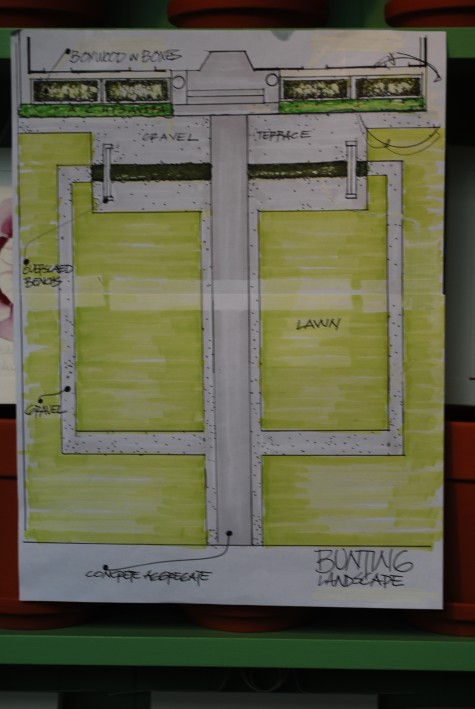 I suggested that she remove all the plants in the front of the house, build four sheet metal boxes, paint them a dark color, and plant them with boxwood. The only in-ground plant along the foundation would be pachysandra. Lawn and gravel panels in simple geometric shapes would be connected by a large square frame of gravel. The frame shape running through the terrace, and under the benches would be planted with some dark foliaged plant material.
I suggested that she remove all the plants in the front of the house, build four sheet metal boxes, paint them a dark color, and plant them with boxwood. The only in-ground plant along the foundation would be pachysandra. Lawn and gravel panels in simple geometric shapes would be connected by a large square frame of gravel. The frame shape running through the terrace, and under the benches would be planted with some dark foliaged plant material.
 Some of my clients like to do their own work-she is one of them. She would come up on occasion for a quick consult on this or that. She made changes to the plan for both practical and aesthetic reasons. She added a row of columnar carpinus on the lot line; the screening was important. Rather than the big picture frame, she installed two limestone gravel squares in the lawn. The installation was very well done.
Some of my clients like to do their own work-she is one of them. She would come up on occasion for a quick consult on this or that. She made changes to the plan for both practical and aesthetic reasons. She added a row of columnar carpinus on the lot line; the screening was important. Rather than the big picture frame, she installed two limestone gravel squares in the lawn. The installation was very well done.
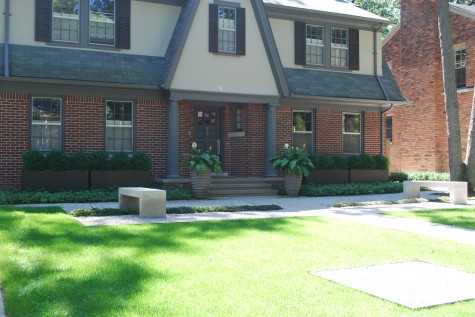 The dark green boxwood in the dark boxes repeat the dark horizontal line of the roof. They seem even darker, as they are always in shade. Squint as you look-they almost disappear. The boxes sit quietly behind the modern Italian beehive pots by Francesca del Re. These pots are the only highly textural element in the landscape. I am sure my client would say that one textural element was enough. She is a very good editor.
The dark green boxwood in the dark boxes repeat the dark horizontal line of the roof. They seem even darker, as they are always in shade. Squint as you look-they almost disappear. The boxes sit quietly behind the modern Italian beehive pots by Francesca del Re. These pots are the only highly textural element in the landscape. I am sure my client would say that one textural element was enough. She is a very good editor.
 The dark run of ajuga is much more about sculpture, and sculptural relationships than it is about the plant. She did however reseach carefully for a small growing, fine textured plant that would tolerate both dry shade, and some sun. Her care in selection has paid off. Though the light conditions change from one place to another, the run is growing and thriving uniformly.
The dark run of ajuga is much more about sculpture, and sculptural relationships than it is about the plant. She did however reseach carefully for a small growing, fine textured plant that would tolerate both dry shade, and some sun. Her care in selection has paid off. Though the light conditions change from one place to another, the run is growing and thriving uniformly.

As I happened to be in the neighborhood, I thought I would stop and take a look. This was my first visit, since she finished the garden. She took my piece of paper, and made something of it. Not being part of the installation process has its rewards. I feel like our exchange, over a piece of paper, came to something good.